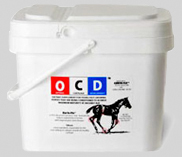I have a 7 month old Arabian filly who was just diagnosed with OCD in both stifles. The lesions are small, no chips or fragments were seen on the x-rays, and they are on a non-weight bearing area of her stiffles. Surgery is not really an option for me at this time since I was laid off from my job last month. She has been on stall rest for the last 3 weeks, since initially she was diagnosed with a twisted fetlock. Once that healed and she was still off, we started looking for where the lameness was coming from. She does have mild effusion in both stifles as well. She was started on OCD pellets the next day. Vet recommended stall rest with daily turn out in a small area to help keep her mental health good. She has been on Triple Crown Senior Feed since going to the trainers in February – prior to that she was creep feeding Purina Senior Feed. She has also been on Platinum Performance since pre-conception. I am bringing her home next week and would like to know!
What do you recommend as a feeding program for an 8 month old with OCD? I have read conflicting views on protein amounts/ nutrition requirements for babies with OCD. Thank you for any help you can provide! Also, am curious, as I have also read conflicting reports: is OCD a genetic disorder? This filly’s full brother had no problems and is sound, but I do know several other foals by her sire which have had OCD problems.
Thank you again!




Amy,
Nutrition has the greatest influence in the total picture. Meeting the nutritional requirements of the skeletal system directly influences the overall health/quality of the bone. Genetics “may” have some influence, but having resolved many OCD lesions with the feeding of OCD Pellets, I am becoming more and more convinced that nutrition has the greatest influence. The latest research shows some interesting points: The significant/high levels of CHO’s (carbohydrates ) we are feeding cause the same in horses as they do in humans – they increase the blood glucose levels – which in turn causes significant increases in insulin. These increases in blood glucose and then insulin have been shown to adversely effect the quality of bone produced. If you look at your feed label it will show two parts of the diet – Protein and Fat. Assuming you are feeding 14% protein and 6% fat(just to make the math easy), that is 20%. Therefore, the rest of your diet/feed (80%) has to be CHO. Let us assume half of the CHO is good CHO (fiber) which is slowly digested and therefore does not result in significant increases in blood sugar and corresponding insulin levels. BUT the other half of your feed (40% of the total diet) is Bad CHO’s (they are called simple CHO’s), mainly sweeteners/molasses and other fillers that feed companies use that make the feed very tasty/sweet. These CHO’s are the culprits – they are what cause blood sugar levels to increase and insulin levels to increase, which significantly influence the quality of bone produced – in this case resulting in poor quality bone. I would suggest you begin by feeding limited amounts of sweetfeed along with oats. I feed 75% oats and 25% sweetfeed (3 to 1). The key however, is to only feed to condition – you do not want to have a FAT baby!!! This excess caloric intake will only result in poor quality bone, and bone lesions, such as bone cysts / epiphysitis/ OCD lesions, etc. You have some effusion in the stifle area now, so I hope you are feeding 2 oz/day of the OCD Pellets. Your Vet is correct in allowing some turnout; but remember, exercise is critical for the formation of good bone, so as soon as you feel comfortable, allow complete turnout. This creates blood flow, as horses do a great deal of walking while grazing and this is very beneficial.
Good Luck. Keep me posted. Thank you for your interest in OCD Pellets and have a great day.
Respectfully,
Dr.D.R. Beebe